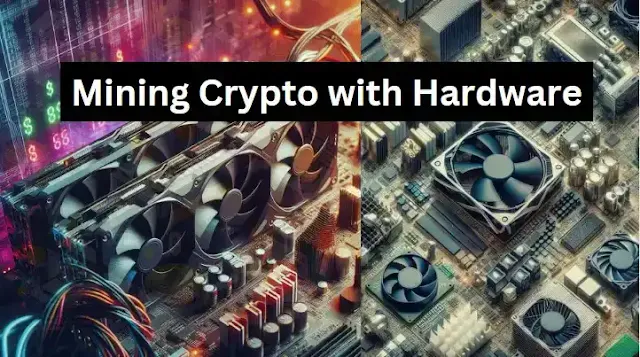In the world of cryptocurrency there is crucial activity that keeps the blockchain network running smoothly using hardware mining.
👉Understanding Hardware Mining
The process of validating and recording transactions on a blockchain network using specialized computer hardware. This method requires miners to solve complex mathematical puzzles, which in turn verifies and adds transactions to the blockchain.
👉Types of Hardware Mining
There are several types of hardware mining setups, each tailored to mine different cryptocurrencies. The two primary methods are ASIC mining and GPU mining.
➤ASIC Mining
ASIC (Application-Specific Integrated Circuit) mining involves using specialized hardware designed solely for mining specific cryptocurrencies. ASIC miners are engineered to perform a single task with exceptional efficiency, making them ideal for high-speed, energy efficient mining. Bitcoin, one of the most popular cryptocurrencies, is often mined using ASIC hardware due to its computational demands.
➤GPU Mining
GPU (Graphics Processing Unit) mining, on the other hand, utilizes graphics cards typically found in gaming computers. These versatile components can be used to mine a variety of cryptocurrencies, offering miners the flexibility to switch between different coins based on profitability.
➤CPU Mining
Computer central processing unit (CPU) as the brain behind your everyday tasks, but did you know it has the potential to do much more? Welcome to the world of CPU mining, where you can put your processor to work to earn digital currencies.
👉Benefits of Hardware Mining
➤Control and Ownership
One of the most significant advantages of hardware mining is the control and ownership it provides to miners. Unlike cloud mining.
➤Profit Potential
successful miners can enjoy consistent returns over time, particularly when they mine cryptocurrencies that experience price appreciation.
➤Network Contribution
By engaging in hardware mining, individuals actively participate in the network's security and decentralization.
👉Challenges and Considerations
➤Initial Investment
initial investment required to purchase mining hardware and set up the necessary infrastructure. However, this investment can often pay off over time, especially during bullish market trends
➤Energy Consumption
Powerful hardware used in mining requires a substantial amount of electricity, which can significantly impact operational costs. Miners must carefully assess energy prices and efficiency to maintain profitability.
➤Hardware Obsolescence
As technology advances at a rapid pace, hardware obsolescence is a legitimate concern. Newer, more efficient hardware models are frequently released, potentially making older equipment less competitive and reducing mining returns.
👉Tips for Successful Hardware Mining
➤Research and Education
Thoroughly research and educate yourself about different cryptocurrencies and their associated mining algorithms. Stay updated on industry trends to make informed decisions about which coins to mine and when to upgrade your hardware.
➤Cost Analysis
Conduct a comprehensive cost analysis before diving into hardware mining. Factor in the costs of equipment, electricity, cooling, and potential maintenance to determine the profitability of your mining operation.
➤Mining Pooling
Consider joining a mining pool, a collective of miners who combine their computing power to increase their chances of solving blocks. Pooling provides more consistent, albeit smaller, rewards and reduces the variance in individual mining outcomes.
👉Conclusion
ASIC mining to the versatility of GPU mining, the world of hardware-based crypto mining offers ample opportunities for those willing to invest time, effort, and resources.




0 Comments